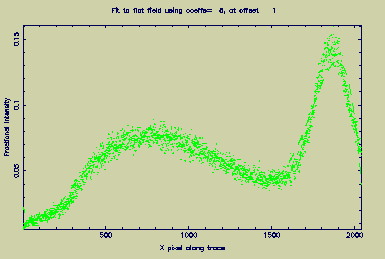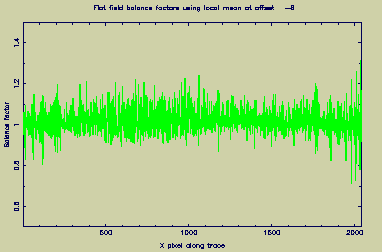 Note that this technique requires that the flat-field orders vary
slowly and smoothly both along and across each order.
Note that this technique requires that the flat-field orders vary
slowly and smoothly both along and across each order.
ECHOMOP will use a flat-field frame if one is available. The flat-field frame should be produced using a continuum lamp exposure with the instrument in an identical configuration to that used for the object exposure (to ensure that any wavelength-dependent behaviour of pixel response is taken into account). The exposure should be of sufficient duration to attain high counts in the brightest parts of the image.
ECHOMOP fits polynomials/splines in two directions; along the traces, and along the image columns. The degree of function fitted can be changed, but the default (low) degree will normally be perfectly reasonable. Each flat-field pixel in an order is then used to calculate a 'balance' factor. This is a number close to unity which represents the factor by which a given pixel exceeds its expected value (predicted by the function).
A typical interactive plot appears below.
 Note that this technique requires that the flat-field orders vary
slowly and smoothly both along and across each order.
Note that this technique requires that the flat-field orders vary
slowly and smoothly both along and across each order.
If required, many flat-field frames (with identical instrument configuration) may be co-added to produce a single high signal-to-noise flat-field frame prior to using ECHOMOP.
At present no special facilities are provided for calculating the actual error on such a co-added flat field; the expected error (derived from root N statistics) is what is used to calculate the error on the balance factors unless appropriate variances are provided in the flat-field frame error array.
A special mode of operation is selected by setting the parameter FLTFIT=MEAN. In this case the balance factors are calculated using the local mean value based on a 5-pixel sample. This will normally be used when the flat field at the dekker limits cannot be modelled because its intensity changes too rapidly on a single-pixel scale due to under-sampling of the profile.
A typical interactive plot appears below.
 Other special modes are available to help model difficult data,
and the type of fit used is primarily selected using the FLTFIT
parameter:
Other special modes are available to help model difficult data,
and the type of fit used is primarily selected using the FLTFIT
parameter:
In the situation where a balance factor frame is independently produced, this may be fed to ECHOMOP as the flat-field frame. The parameter TUNE_PREBAL should then be set to YES.
In this case the modelling will not take place and the balance factors will simply be copied from the supplied frame. This should be used for special cases where the polynomial model cannot generate appropriate values.
In cases where no flat-field frame is available then the parameter TUNE_NOFLAT=YES can be specified; or alternatively FFIELD=NONE set when prompted for the name of the flat-field frame. In either case, all balance factors will be taken to be unity.
Martin Clayton